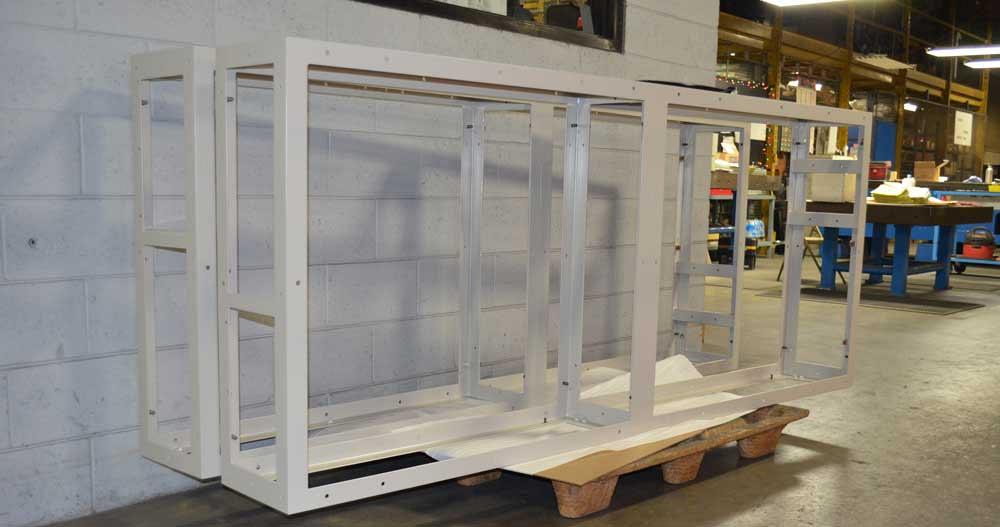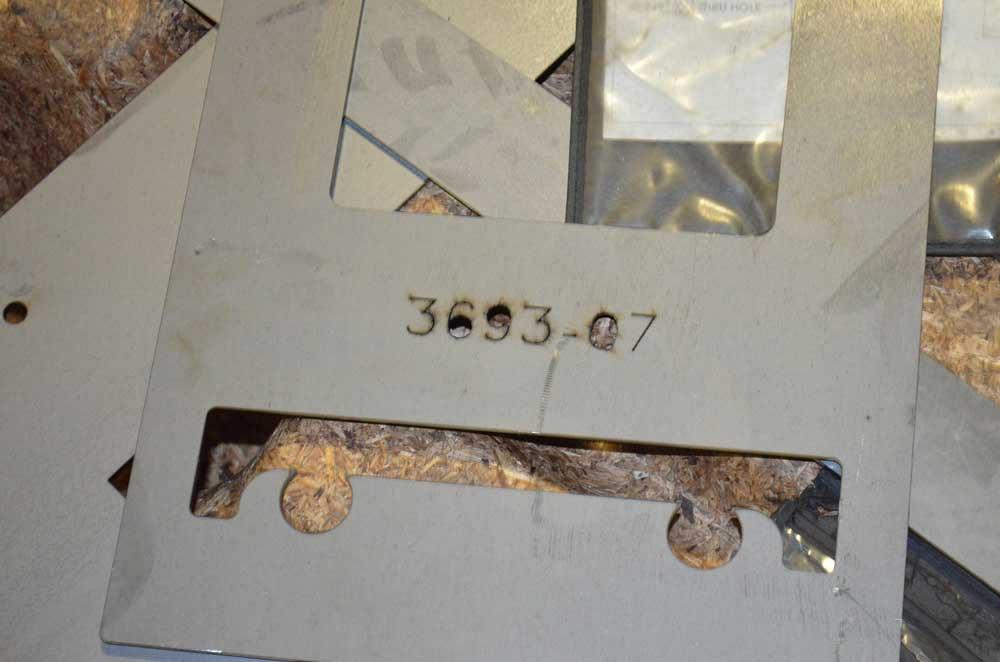Editor-in-Chief
- FMA
- The Fabricator
- FABTECH
- Canadian Metalworking
Categories
- Additive Manufacturing
- Aluminum Welding
- Arc Welding
- Assembly and Joining
- Automation and Robotics
- Bending and Forming
- Consumables
- Cutting and Weld Prep
- Electric Vehicles
- En Español
- Finishing
- Hydroforming
- Laser Cutting
- Laser Welding
- Machining
- Manufacturing Software
- Materials Handling
- Metals/Materials
- Oxyfuel Cutting
- Plasma Cutting
- Power Tools
- Punching and Other Holemaking
- Roll Forming
- Safety
- Sawing
- Shearing
- Shop Management
- Testing and Measuring
- Tube and Pipe Fabrication
- Tube and Pipe Production
- Waterjet Cutting
Industry Directory
Webcasts
Podcasts
FAB 40
Advertise
Subscribe
Account Login
Search
Better organization of assembly templates
An ever-expanding fabricating job requires better template organization at KSM Industries Inc.
- By Dan Davis
- March 3, 2014
- Article
- Assembly and Joining

Figure 1:
This rack mount for power equipment is an example of just one size that KSM Industries fabricates for its customer. Specs for this fabrication call for the use of structural angles and channels, usually around 0.25 in. thick, instead of bent sheet metal sections.
Metal fabricators always welcome an increase in business, but success sometimes brings its own challenges.
KSM Industries Inc. is a Germantown, Wis.-based contract metal fabricator that has been serving OEM customers in the agricultural, construction equipment, material handling, lawn and garden, power generation, material handling, and transportation industries since 1971. From its 140,000-square-foot facility it offers fabricating, welding, powder coating, and assembly services.
Almost two years ago, a customer approached KSM to quote on the fabricated portion of some larger assemblies. In this case, the fabrications were rack mounts for power equipment (see Figure 1). The job specifications called for the racks to be made of structural angles and channels, which required drilled holes, tapped holes, weld studs, and weld nuts to be located throughout the weldments. These fabricated features required relatively tight centerline-to-centerline tolerances at each location—usually ± 0.020 in.—from one feature to the next and from one plane to the other.
KSM won the job and commenced fabricating the racks. Initially the company’s fabricators discovered that they would be able to predrill (see Figure 2), -punch, and -tap some features on the fabricated sections prior to welding, but that for the most part, much of that had to be done after the frames were completely assembled. Inconsistencies in shape from one structural form to the next and material changes related to heat expansion and contraction during the welding process worked against front-end fabrication feature work.
Templates were needed to complete the job efficiently and correctly.
As the Business Grew …
Templates are nothing new to job shops. They’ve been used for years to guide fabricators in the placement of drilled holes and hardware, and they would work for this application as well. Rick Briscki, a KSM manufacturing engineer, said the CAD files were used to cut out the template for a specific job, and the file was sent to the floor to be cut. These “picture frame/pick-off” templates, as Briscki called them, were made of 12-gauge steel and cut on one of the company’s three Mazak lasers (see Figure 3).
Fabricators simply retrieved the template they needed, aligned it against one end of the frame, clamped it into place, and proceeded with applying the last fabrication details. Shop floor personnel were able to find the correct template because the tool number was included on the corresponding router. (All identification numbers for templates and fixtures were kept on a tool log file, a spreadsheet file containing the part number connected to the template/fixture; a description, such as whether it was a drill or weld template; shop location; the date it was first entered into the file; and any additional comments, such as if the template had more than one piece or if more than one of the same template existed.)
Early on this organizational approach worked well. The templates were few, and they simply were placed on pallets near either drilling or the welding area, where the hardware was affixed.
… The Number of Templates Grew
But as the OEM customer pushed more rack mount assembly work KSM’s way, the number of templates grew. And the organizational mess grew as well. What started out as a few templates on a few pallets expanded to too many templates on too many pallets. Pallets were stacked on top of each other. They were placed on shelves. Some templates simply were left leaning against a wall or placed in any available open space.
The organizational nightmare was made worse by the complexity of some of the templates. For instance, one frame assembly required 25 templates, which became increasingly difficult to keep together as the number of other templates grew.

Figure 2:
A drilled hole like this has to be precisely placed according to the centerlines of other holes on the rack mount. KSM Industries discovered that in most cases, this could be done only after the frame had been completely assembled.
“It was difficult for shop personnel to locate the required templates as they were scattered all over the shop,” Briscki said.
Ultimately, this search for lost templates was causing delays in job turnaround. Even when they knew where the template was, shop floor personnel still needed time to reach it. Sometimes pallets of other templates were in the way and needed to be moved with a lift truck to access the pallet with the right template. In other instances, if the template couldn’t be located or it was damaged after sitting under other steel templates, another template had to be laser-cut, holding up the shop order until the template was ready.
KSM Industries needed some organizational intervention.
Designing Racks to Hold Rack Templates (and More)
At the beginning of 2012, KSM’s manufacturing supervisors, engineers, and shop floor personnel came together to develop a means to organize the growing number of templates. The consensus was a racking system for all templates, not just the ones used on the rack mounts.
The initial vision was for a racking system with pull-out doors, but that approach was deemed too complex and too expensive to pull off. The final vision incorporated racks made of expanded metal in a diamond pattern that was less expensive to fabricate and provided transparency to help shop lighting illuminate each rack (see Figure 4).
One of these racks is located in the drilling area, and two can be found in the welding shop. If an employee needs to locate a template, designated by a number on the job router, he can go to the rack and fan through the individual sections like the poster display at Spencer’s in the mall.
The tooling template log, which contains all of the template numbers, indicates the rack location and panel number, and that template number is clearly marked on the storage rack (see Figure 5). Briscki said the company initially thought about naming the racks according to their location in the building, such as the North Rack, but realized that such a naming approach could grow complicated as more racks were added. Would racks then be called North Rack 2 or North-Northwest Rack? A numbering configuration seemed a lot simpler.
When a template is used for the first time, the welder or drill operator who uses it is required to mark it up prior to storage (see Figure 6). The markings include directions on how to place it on the frame and just where the holes need to be made or the hardware needs to be placed. After the job is completed, the template is stored in the next available storage rack location, and that location is recorded in the tool log. If the job is repeated, the template can be located easily, and the employee can return it to the storage location once the operation is completed.
The next generation of storage racks recently has been introduced to the KSM shop floor (see Figure 7). These racks have 12 panels on each side for maximum storage potential.
Looking back since KSM started using the storage racks, Briscki said it’s hard to find a quantifiable measurement that really summarizes the impact that this new organizational approach has had. He has no doubts, however, that the racks are a definite improvement.
“It would be safe to say that across one shift, given the number of orders that require templates, at least two hours of lost production time per day is recovered due to the use of this new, organized rack system,” Briscki said.
About the Author

Dan Davis
2135 Point Blvd.
Elgin, IL 60123
815-227-8281
Dan Davis is editor-in-chief of The Fabricator, the industry's most widely circulated metal fabricating magazine, and its sister publications, The Tube & Pipe Journal and The Welder. He has been with the publications since April 2002.
subscribe now

The Fabricator is North America's leading magazine for the metal forming and fabricating industry. The magazine delivers the news, technical articles, and case histories that enable fabricators to do their jobs more efficiently. The Fabricator has served the industry since 1970.
start your free subscription- Stay connected from anywhere

Easily access valuable industry resources now with full access to the digital edition of The Fabricator.

Easily access valuable industry resources now with full access to the digital edition of The Welder.

Easily access valuable industry resources now with full access to the digital edition of The Tube and Pipe Journal.
- Podcasting
- Podcast:
- The Fabricator Podcast
- Published:
- 04/16/2024
- Running Time:
- 63:29
In this episode of The Fabricator Podcast, Caleb Chamberlain, co-founder and CEO of OSH Cut, discusses his company’s...
- Trending Articles
AI, machine learning, and the future of metal fabrication

Employee ownership: The best way to ensure engagement

Steel industry reacts to Nucor’s new weekly published HRC price

Dynamic Metal blossoms with each passing year

Metal fabrication management: A guide for new supervisors

- Industry Events
16th Annual Safety Conference
- April 30 - May 1, 2024
- Elgin,
Pipe and Tube Conference
- May 21 - 22, 2024
- Omaha, NE
World-Class Roll Forming Workshop
- June 5 - 6, 2024
- Louisville, KY
Advanced Laser Application Workshop
- June 25 - 27, 2024
- Novi, MI



























